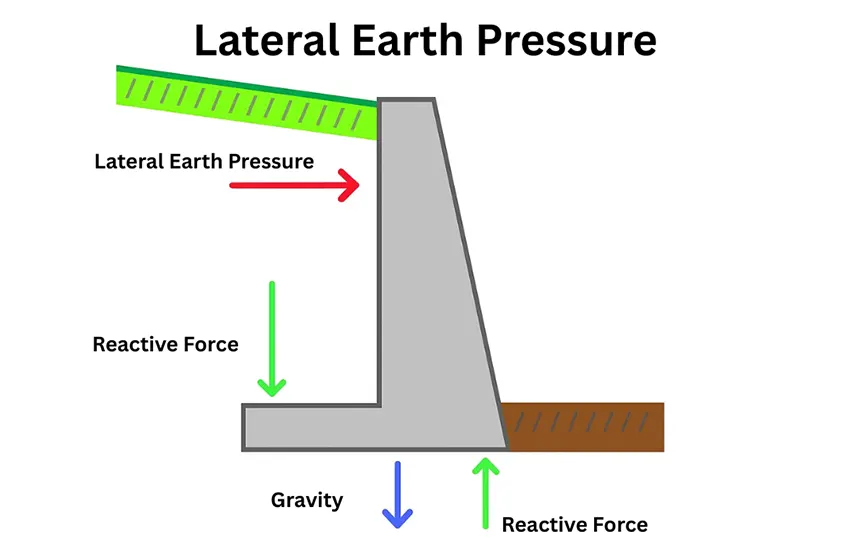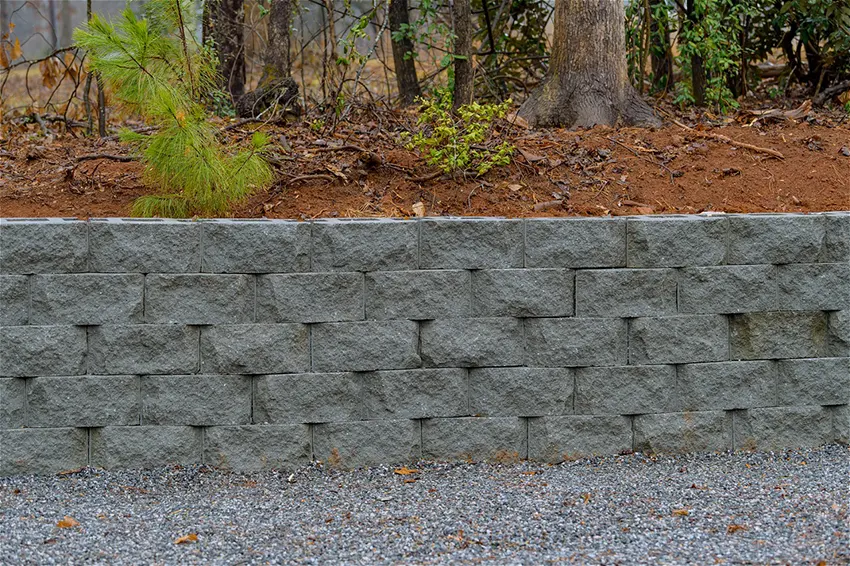Lateral earth pressure is the sideways force that soil exerts on your foundation walls when it becomes saturated. In Long Island communities like Suffolk, Nassau, Brooklyn, Queens, and the Bronx, heavy rains, poor drainage, and high water tables can make that pressure spike. Over time, it can cause cracks, bowing walls, and leaks—problems that only get worse without action.
At Zavza Seal, we address the root cause with proven drainage, waterproofing, and structural reinforcement solutions that keep your home safe. Ahead, you’ll learn the key signs of this pressure, why it happens, and how we restore your foundation’s integrity.
Schedule Your Free Inspection Today

What Is Lateral Earth Pressure?
Lateral Earth pressure is the sideways force that soil places against basement, retaining, and foundation walls when it soaks up water and expands. The deeper the wall, the stronger the pressure, which is why basements and retaining walls often show the most damage.
Soil moves horizontally when clay swells, when drainage fails, or when the ground shifts from poor compaction. Over time, these cycles can cause cracks, leaks, or walls that begin to bow inward. Walls are designed with reinforcement to resist this stress, but when water and soil pressure exceed those limits, problems start to show.
If you’ve seen your basement wall bulging inward or a retaining wall leaning, it’s not just a cosmetic issue—it’s lateral pressure at work, and it needs attention before it gets worse.
Causes of Lateral Pressure
Several conditions can drive soil pressure up and put stress on your foundation walls:
- Soil Type And Moisture: Clay soils swell when wet and shrink when dry, creating ongoing stress.
- Hydrostatic Pressure: Standing water or clogged drainage builds weight behind walls.
- Surcharge Loads: Extra weight from landscaping, parked vehicles, or nearby structures increases soil pressure.
- Poor Compaction And Construction: Weak footings, missing reinforcement, or sloppy backfilling leave walls vulnerable.
- Erosion And Frost: Erosion creates voids behind walls, while frost heave pushes soil outward with force.
When left unchecked, these factors don’t just cause cracks—they can lead to wall failure. Ignoring them may save money in the short term, but it almost always results in costly structural repairs later.
Signs of Lateral Pressure Problems
Walls rarely fail without warning—they send out signals first. Catching these signs early can save homeowners from costly repairs and major structural damage.
- Leaning Or Bulging Walls: Any bowing, leaning, or inward bulge is a clear sign that soil pressure is winning.
- Cracks And Fractures: Horizontal or stair-step cracks often mean the wall is under serious stress.
- Dry Weep Holes: If no water drains after rain, blocked weep holes are allowing hydrostatic pressure to build.
- Subsidence And Soil Movement: Sinkholes, shifting soil, or depressions near the wall suggest a looming failure.
- Odors And Moisture: Musty smells or damp patches point to water infiltration through stressed walls.
These are the classic signs of retaining wall failure and shouldn’t be brushed aside. A wall that smells like a basement gym isn’t getting healthier. If you’ve spotted any of these issues, it’s time to call for a free inspection before the problem escalates.
Understanding Active Lateral Earth Pressure
Active lateral earth pressure occurs when a wall tilts or shifts slightly away from the soil, relieving some of the horizontal stress. But “less pressure” doesn’t mean “no problem.” Even reduced force can cause cracks, leaks, or gradual damage over time.
Typical scenarios include leaning garden retaining walls after heavy rainfall or older homes where shifting soil has pushed walls out of alignment. While the soil pressure may seem reduced in these cases, it’s still strong enough to crack masonry and compromise waterproofing.
Early intervention is key. Solutions like improved drainage, helical anchors, or wall tiebacks can stabilize the structure before major damage sets in. Don’t wait until your wall waves goodbye—addressing active soil pressure early is always cheaper than replacing a failed wall later.
Understanding Passive Lateral Earth Pressure
Passive lateral earth pressure is the soil’s pushback when a wall pushes into it. Think of it as the ground resisting sliding or overturning forces. This resistance is only mobilized when walls are already shifting, which means the structure is already in trouble.
Relying on passive resistance can be risky. If the soil is loose, saturated, or poorly compacted, it won’t provide the strength needed to hold the wall. In those cases, failure happens fast.
That’s why professional evaluation is critical—only an expert can determine whether passive soil pressure is offering real resistance or giving a false sense of security. DIY calculations won’t cut it here; leave it to the engineers instead of rolling the dice on your foundation.
Understanding Lateral Earth Pressure At Rest
Lateral earth pressure at rest is the condition when a wall does not move, and as a result, the stress it absorbs can actually be higher than in the active state. This type of pressure is especially important for rigid walls that have little or no flexibility.
Common scenarios include basement walls, swimming pool walls, buried tanks, and stiff retaining walls supported with tiebacks. Pressure increases with depth, which means lower wall sections are often the most vulnerable. Without proper design and waterproofing, these walls can crack, leak, or even fail under sustained at-rest soil pressure.
Your basement walls aren’t supposed to be yoga mats—no flex allowed. If your property relies on rigid walls, a free evaluation is the smart way to keep them standing strong.
Calculating The Lateral Earth Pressure Coefficient
The lateral earth pressure coefficient (K) is the ratio of horizontal to vertical stress in soil, and it plays a central role in retaining wall design. There are three values to know: Ka (active), Kp (passive), and K₀ (at rest).
- Ka (Active): Applies when the wall tilts or moves slightly away from the soil, typically less than 1.
- Kp (Passive): Applies when the wall pushes into the soil, usually greater than 1.
- K₀ (At Rest): Applies when the wall remains fixed, often resulting in higher stresses.
Factors that affect these coefficients include soil friction angle, cohesion, density, drainage conditions, wall roughness, and how much the wall moves. Miscalculations can have costly results—underestimating means walls that bow or crack, while overestimating means wasting money on unnecessary reinforcements.
Although engineers use popular theories like Rankine or Coulomb to calculate soil pressure coefficients, homeowners shouldn’t try to crunch these numbers on their own. Calculators won’t save your basement—professional design will.
Solutions & Repairs
Once lateral pressure problems are identified, there are proven solutions to repair damage and prevent it from returning:
- Drainage Improvements: Install French drain systems, weep holes, and sump pumps to relieve hydrostatic pressure.
- Soil Stabilisation: Strengthen backfill with compaction, densification, or polyurethane injections.
- Structural Reinforcements: Use helical piers, wall anchors, tiebacks, or carbon fiber wraps to stabilize and pull walls back.
- Waterproofing: Apply membranes and protective coatings to stop water from seeping in.
Every repair depends on proper installation and design. The sooner issues are addressed, the less invasive and costly the fix. Better to anchor now than rebuild later.
Conclusion
Lateral earth pressure is no small issue—it can crack walls, allow leaks, and trigger expensive repairs if ignored. Soil type, moisture levels, construction quality, and wall design all determine whether your foundation holds strong or gives way under pressure.
Don’t gamble with your home’s safety or value. Zavza Seal provides expert inspections, tailored drainage and waterproofing systems, and structural reinforcements that protect your foundation for decades to come.
For homeowners in Long Island, Brooklyn, Queens, and the Bronx, the right time to act is now. Schedule your free inspection today and let our team deliver lasting foundation protection and peace of mind.
What Causes Retaining Walls To Crack?
Soil movement, hydrostatic pressure, poor design, and heavy surface loads are the main culprits. If your wall is cracking, contact us for a professional inspection.
How Do You Reduce Lateral Earth Pressure?
Improve drainage, remove surcharge loads, and reinforce the wall. A professional evaluation ensures the right fix for your soil.
What Is The Difference Between Active And Passive Lateral Earth Pressure?
Active occurs when the wall moves away from the soil; passive occurs when the wall pushes into it. Learn more in our structural solutions section.
How Do You Calculate Lateral Earth Pressure?
Engineers use Ka, Kp, and K₀ coefficients with soil properties and design factors. Don’t DIY—professional design is critical.
Why Is Drainage Important For Retaining Walls?
Proper drainage prevents hydrostatic pressure from building up and causing failure. Explore our drainage solutions.
Which Type Of Retaining Wall Is Best For My Soil?
Gravity, cantilever, piling, and anchored walls each work in different conditions. Consult our experts for site-specific advice.








